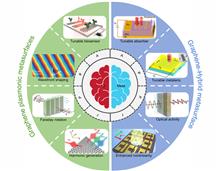 View fulltext
View fulltext
Metasurfaces, with extremely exotic capabilities to manipulate electromagnetic (EM) waves, have derived a plethora of advanced metadevices with intriguing functionalities. Tremendous endeavors have been mainly devoted to the static metasurfaces and metadevices, where the functionalities cannot be actively tuned in situ post-fabrication. Due to the intrinsic advantage of active tunability by external stimulus, graphene has been successively demonstrated as a favorable candidate to empower metasurfaces with remarkably dynamic tunability, and their recent advances are propelling the EM wave manipulations to a new height: from static to dynamic. Here, we review the recent progress on dynamic metasurfaces and metadevices enabled by graphene with the focus on electrically-controlled dynamic manipulation of the EM waves covering the mid-infrared, terahertz, and microwave regimes. The fundamentals of graphene, including basic material properties and plasmons, are first discussed. Then, graphene-empowered dynamic metasurfaces and metadevices are divided into two categories, i.e., metasurfaces with building blocks of structured graphene and hybrid metasurfaces integrated with graphene, and their recent advances in dynamic spectrum manipulation, wavefront shaping, polarization control, and frequency conversion in near/far fields and global/local ways are elaborated. In the end, we summarize the progress, outline the remaining challenges, and prospect the potential future developments.
Nonscattering optical anapole condition is corresponding to the excitation of radiationless field distributions in open resonators, which offers new degrees of freedom for tailoring light-matter interaction. Conventional mechanisms for achieving such a condition relies on sophisticated manipulation of electromagnetic multipolar moments of all orders to guarantee superpositions of suppressed moment strengths at the same wavelength. In contrast, here we report on the excitation of optical radiationless anapole hidden in a resonant state of a Si nanoparticle utilizing a tightly focused radially polarized (RP) beam. The coexistence of magnetic resonant state and anapole condition at the same wavelength further enables the triggering of resonant state by a tightly focused azimuthally polarized (AP) beam whose corresponding electric multipole coefficient could be zero. As a result, high contrast inter-transition between radiationless anapole condition and ideal magnetic resonant scattering can be achieved experimentally in visible spectrum. The proposed mechanism is general which can be realized in different types of nanostructures. Our results showcase that the unique combination of structured light and structured Mie resonances could provide new degrees of freedom for tailoring light-matter interaction, which might shed new light on functional meta-optics.
Photonic topological insulators with robust boundary states can enable great applications for optical communication and quantum emission, such as unidirectional waveguide and single-mode laser. However, because of the diffraction limit of light, the physical insight of topological resonance remains unexplored in detail, like the dark line that exists with the crystalline symmetry-protected topological edge state. Here, we experimentally observe the dark line of the Z2 photonic topological insulator in the visible range by photoluminescence and specify its location by cathodoluminescence characterization, and elucidate its mechanism with the p-d orbital electromagnetic field distribution which calculated by numerical simulation. Our investigation provides a deeper understanding of Z2 topological edge states and may have great significance to the design of future on-chip topological devices.
In this article, we review recent advances in the technology of writing fiber Bragg gratings (FBGs) in selected cores of multicore fibers (MCFs) by using femtosecond laser pulses. The writing technology of such a key element as the FBG opens up wide opportunities for the creation of next generation fiber lasers and sensors based on MCFs. The advantages of the technology are shown by using the examples of 3D shape sensors, acoustic emission sensors with spatially multiplexed channels, as well as multicore fiber Raman lasers.












